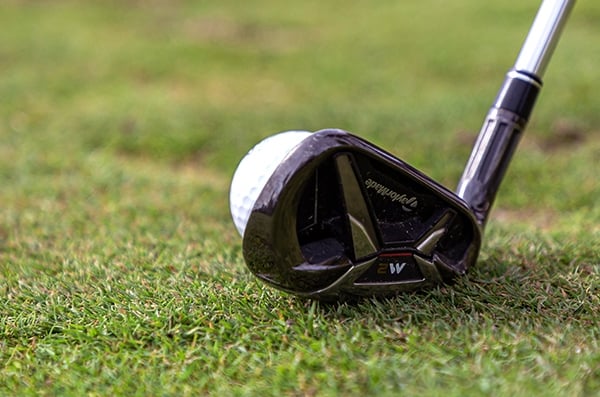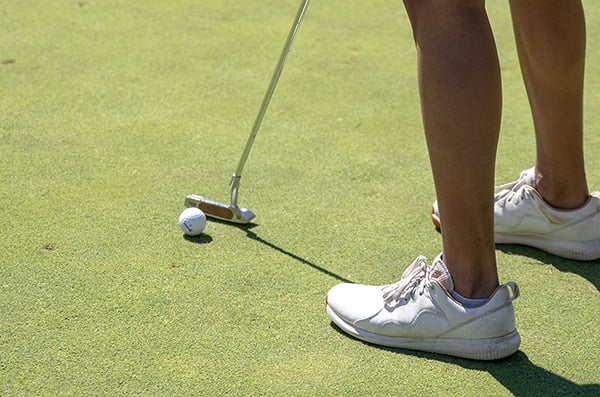-
{{link.label}}{{link.label}}
How to Choose a Putter: A Beginner's Guide
On this page
It’s often forgotten by golfers, but your putter is the most important club in your bag. You use it on almost every single hole once your ball is on or near the green. Since it can have such a massive impact on your scorecard, every golfer needs to play with the right putter for them.

With so many options and styles available for you to choose from, many golfers will need a hand to find the right putter for their playing style. Lucky for you, Golf Avenue is here to help you by breaking down the different aspects that make up a putter, how each of these aspects can affect your putting strokes, and, finally, help you find a putter suited to your playing style.
This guide will help your find the right putter by:
- Breaking the different parts that make up the putter
- Helping you identify your needs and what putters will cater to those needs
- Comparing the different price tags associated with each putter
Make sure to read this one to the end as we’ll be providing you with putter suggestions for different budgets and different types of golfers.
What are the different types of putter clubheads?
You’ll find three main categories of putter clubheads on the market: the blade, the mallet, and the half-mallet. Each clubhead style answers the needs of specific golfers on the green. With the right putter in hand, you’ll feel much more confident any time you step up to your ball on the green to putt.
Blade putters
The blade is the traditional putter shape that you’ll most likely think about when imagining a putter in your head. If you’ve ever seen Tiger Woods on a green, you’ve probably noticed his iconic Scotty Cameron Select Newport putter. It’s perhaps the most iconic blade putter in modern times.

Most blade putters will feature a toe hang as they tend to be better suited for golfers with an arched putting stroke. The clubhead of blade putters also tends to be slightly lighter than the clubhead of bulkier models.
Mallet putters
The mallet putter is the counterpart of the blade putter. You’ve perhaps seen some of these before, or you might even have one already. These are the largest clubheads you can find on the market. Dustin Jonhson has been loyal to his TaylorMade Spider putter, a perfect example of a mallet model.
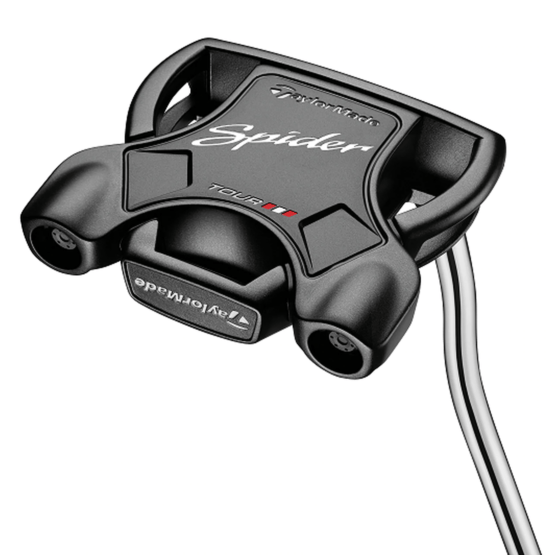
Most mallet putters feature a face-balanced clubhead that allows the clubhead to remain perpendicular to the target, throughout your swing, which means that it is ideal for golfers with a straight back-and-forth putting stroke. Stability is key for those golfers with such a swing path.
Half-mallet putters
As the name suggests, half-mallet putters are midway between the thin and agile clubhead of blade putters and the bulky forgiving clubhead of mallet putters. One of the greatest perks of the half-mallet is that they provide a balance between the toe hang and the face balance.
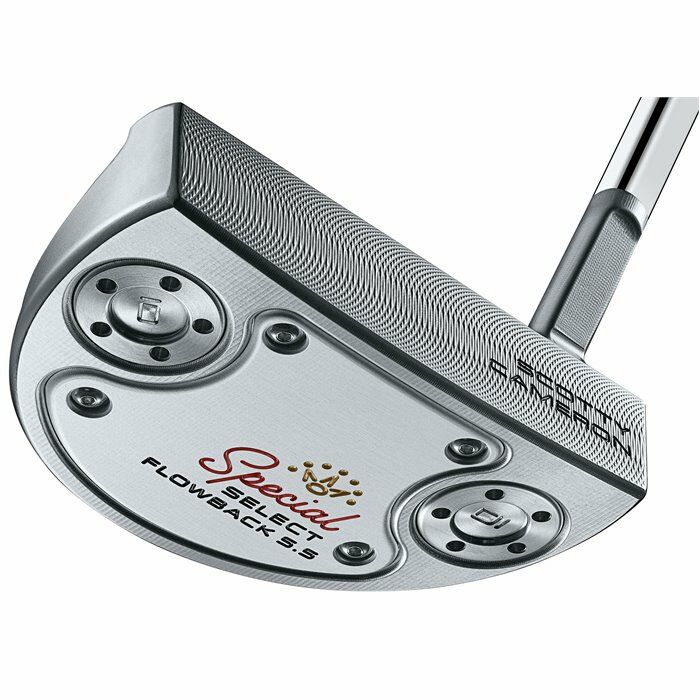
In other words, half-mallets are offered in such a great variety that you’ll be able to find different blends of face-balanced and toe hang that can adjust exactly to your swing. This is most useful for golfers who have an arched back swing, but a straightforward downswing when putting.
How to choose the right clubhead balance for your putter?
As stated previously, putters come in all shapes and sizes, but a lesser-known fact about them is that they offer a wide variety of balance in the clubhead, commonly referred to as “Toe Hang” or “Face Balanced”. This refers to the location of the weight in the clubhead of your putter.
How to test the balance of a putter’s clubhead?
To test the balance of a clubhead, simply lay the putter shaft flat in your palm, about 5 inches away from the clubhead. Depending on the balance of your club, the clubhead will either turn and drop or will stay up. Let’s see what each of these results represents.
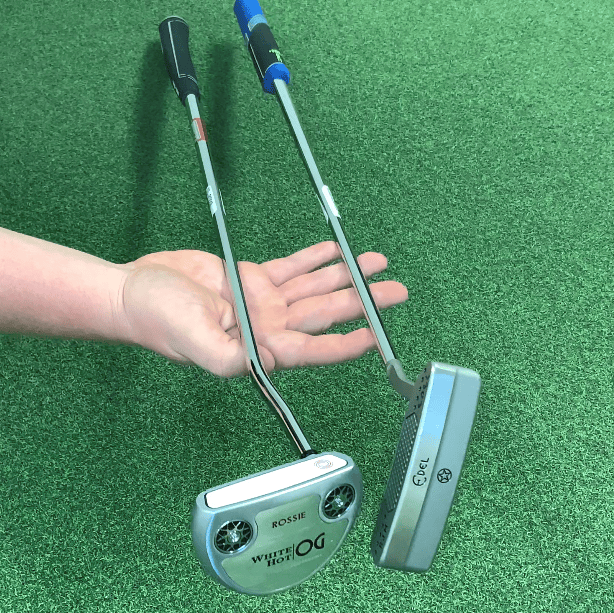
Toe Hang Putters
When completing the balance test with your clubhead, you’ll notice a toe-hang when the face of your clubhead turns to the side and the toe of your clubhead points towards the ground. This means that the weight of the clubhead is mostly balanced towards the toe of the putter.

This type of clubhead balance is best suited for golfers with an arched putting stroke. The extra weight in the toe of the putter allows golfers with an arched stroke to benefit from added inertia at impact. The weight prevents the arched stroke from being exaggerated, allowing for a more consistent arc.
Face Balanced Putters
When completing the balance test, you’ll notice a face-balanced putter when the clubhead hangs sideways in your palm (clubface towards the sky). Contrary to the toe hang, the weight inside a face-balanced putter is focused on the clubface of the putter.
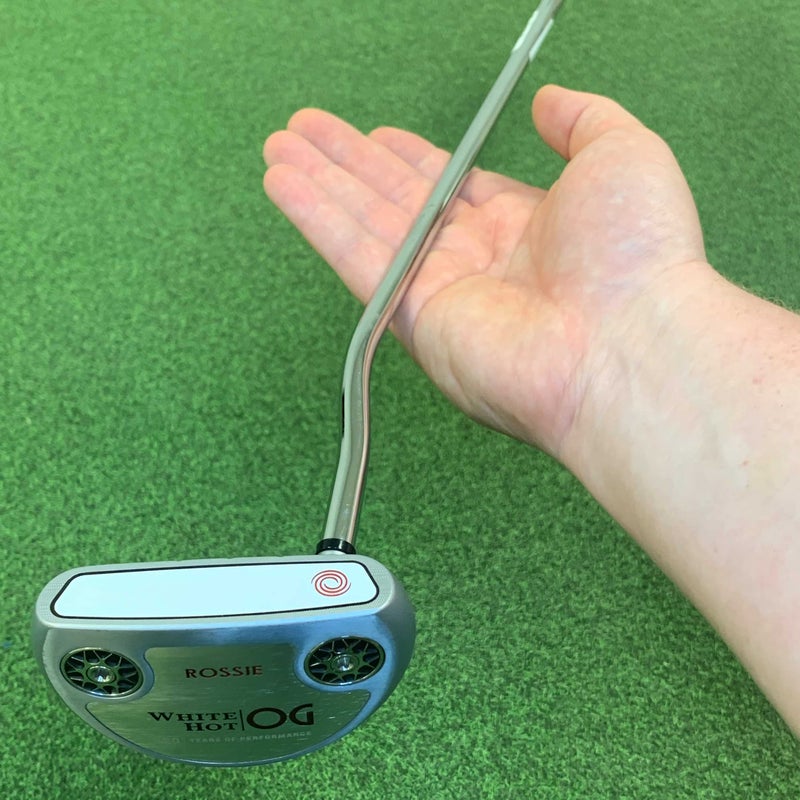
Face-balanced putters are usually best suited to golfers with a straight back-and-forth stroke. These tend to make for highly forgiving clubheads, ideal for golfers with a straight back-and-forth stroke, as many tend to struggle to have a constant stroke path or hit the ball in the same spot on the face.
Choosing a Shaft
Now that you’ve checked all the boxes regarding your putter’s clubhead, it’s now time to look at its shaft. Unlike the shafts of longer clubs like drivers or irons, the flex of your shaft is not as much of a factor. Rather, the length of the shaft is truly what matters with putters.
Most putters sold on the market will be in the range of 33 to 35 inches as this range will suit most golfers. When shopping for pre-loved golf putters, there’s always a chance that you run across a putter with an unorthodox shaft length, which is why you should always look carefully at the listing.
How to find the right shaft length for my putter?
The length of your putter’s shaft is directly related to your height. Indeed, the taller you are, the longer your shaft will need to be.
Generally, golfers shorter than 5’9’’ should consider using a 33-inch putter, while golfers in the 5’9” to 6’0” range should consider 34-inch putters, and golfers between 6’0” and 6’3” should turn to a 35-inch putter. Golfers taller than 6’3” or shorter than 5’6” will often need to consider customized putters.
The chart below details shaft length recommendations based on your height.
| Golfer's Height |
Putter Length |
|
Under 5’0” |
32” |
|
5’0” to 5’3” |
32.5” |
|
5’3” to 5’6” |
33” |
|
5’6” to 5’9” |
33.5” |
|
5’9” to 6’0” |
34” |
|
6’0” to 6’3” |
34.5” to 35” |
|
Taller than 6’4” |
35.5” or longer |
Choosing a Grip
When it comes to putter grips, the variety is almost endless. They come in all sorts of lengths and sizes to cater to the different needs of golfers on the market. Most putters on the market will be outfitted with a regular-sized grip that usually features the name of the manufacturer.
One of the beauties of shopping for pre-loved golf clubs is that you can come across so many different types of putters with an incredible variety of grip styles. This means that the putter you’ve been looking for might be fitted with the grip you were planning to install on it already!
The size of your grip will play a key role in your feel for the golf ball at impact when you’re on the green. So, let’s see how bigger grips stack up against smaller ones.
Why choose a bigger grip size?
A bigger grip will limit any twitching in your motion as well as limit the hinge action you might have in your wrists. Golfers who suffer from arthritis will also benefit from using a larger grip as it’ll prevent them from having to close their hands too tight on their grip.
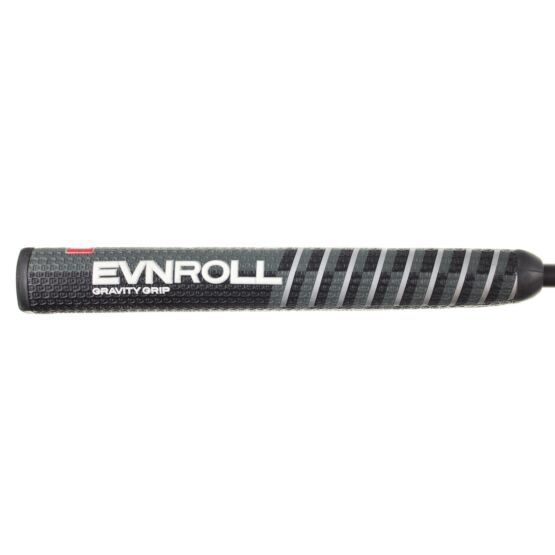
The larger grip will also represent a heavier weight in your hands, which will counterbalance the weight of your clubhead. In some cases, this will make putting easier for some, while others will need to add more weight to their clubhead.
Why choose a smaller grip size?
A smaller grip will provide a better feel for the ball and allow for better control of your putting stroke. Players who like to let their hands do the work on the green will especially appreciate this type of grip as the movement of your hands can greatly affect the result of your putts.
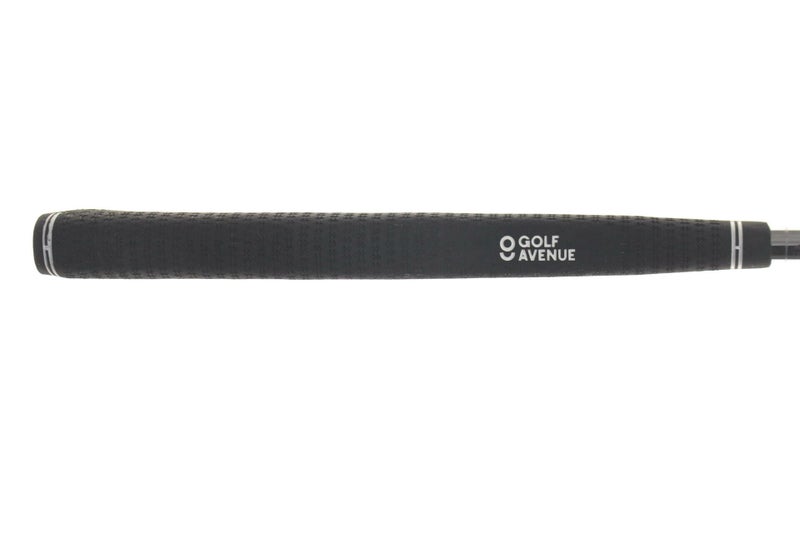
Many golfers will also argue that a smaller grip simply feels more natural to hold than bigger models. Additionally, smaller grips are lighter which means that the weight of your clubhead will have an impact.
How Do You Know Which Putter Is Best for You?
This is a loaded question, as a lot of factors will influence your final decision when it comes to choosing the right putter for you. As mentioned in the first part of the article, the balance of the clubhead, as well as its size and weight, the shaft length, and the grip size. But your skill level also needs to be considered as it will affect your choice in the end, and most important, you need to consider your putting stroke!
What is Your Putting Stroke?
Everyone’s got their stroke that they’ve perfected over time, but almost any putting stroke can be classified under one of the three main categories of putting strokes.

Arched Stroke
The first is the arched stroke, which closely resembles the club path of a regular swing with a full-length club.
Straight Back-and-Forth Stroke
The second is the straight back-and-forth putting stroke, which is also widely popular amongst golfers everywhere.
Slightly Arched Stroke
Finally, we’ve got the intersection of the two with the slightly arched stroke, which produces a backswing like the arched stroke (slightly less arched) and a straight-forward swing motion, which is more similar to the straight back-and-forth stroke.
How to find out what your putting stroke is?
Many golfers will be able to identify which type of stroke they are using, without giving it too much thought. But the truth is that not every golfer can identify what type of putting stroke they use so simply. Lucky for them, Golf Avenue has a detailed step-by-step test for you to do at home.
- First, you’ll need a putter. No matter what type of model, you’ll simply use it as a visual reference during this test.
- Set yourself up anywhere you like, but make sure that the ground that surrounds you is flat so that your results avoid being skewed.
- Assume your putting position as if you were lining up for a putt on the course.
- Next, set up two alignment sticks that run along your putter. Leave about an inch or half of one between the alignment sticks and the toe and the heel of your putter.
- Finally, take practice swings with your natural putting stroke. After taking a few swings, take your club back as if you were to take another swing, but stop your motion in the back swing.
- If your clubhead is over the alignment stick that is closest to you, that means that the first part of your backswing is arched. If the clubhead hangs between the two sticks, your motion will most likely be entirely straight back and forth.
- Take a few more swings and after five or six, hold the finish. Here again, look at where your clubhead hangs after completing your stroke. If it’s above the closest alignment stick, your forward motion is arched, and if it hangs between the sticks, your forward motion is also straightforward.
This process should allow you to determine what stroking motion is most natural to you. Keep in mind that you don’t need alignments sticks for this exercise. You can replace them by setting up two golf clubs along the ground or even set up two straight lines on the ground by drawing them or setting up lines of tape.
What is the best putter for beginner golfers?
There is no ultimate go-to solution here, but beginners should strongly consider mallet putters. These putters provide the highest level of forgiveness on every stroke, which is key for beginners who struggle with putting consistency.
Mallet putters usually feature a face-balanced technology, another great perk that beginners will appreciate as they often struggle to repeat the same stroke when putting. The larger clubhead will also limit the effects of twitching which are also common when it comes to beginners.
Here’s what a beginner should look for in a putter:
- A massive clubhead that will offer forgiveness
- A face-balanced putter that allows for a straighter swing path
- An affordable option as their game might develop the need for a different model at some point
What is the best putter for the average golfer?
Here again, there’s no simple solution to this question, but there are some key details to keep in mind when shopping for a putter as an average golfer. The most important aspect to prioritize as an average golfer is your feel for the ball with your putter and how comfortable you are with it.
Many golfers will tend to prioritize the name or the reputation of a putter over their comfort with it. Instead, go over the different parts that make up your putter and make sure that each one of them suits you so that you can buy a trusty putter that you’ll be able to keep for a long time.
Here’s what the average golfer should look for in a putter:
- A putter that checks all the technical boxes (shaft length, clubhead weight, balance, and shape)
- A putter that is suited to your natural putting stroke (straight, arched, half-arched)
- A putter that provides you the desired level of feel for the ball at impact
How much budget should I set aside from my putter?
Your level of play, the number of rounds you play, your confidence level in your selection, and your total budget will all have an impact on the amount of money you should spend on a putter. While everyone is different, there are still a few standards that you should consider when picking your putter.
How much money should a beginner spend on a putter?
Ideally, the answer would always be zero and beginners would be offered hand-me-downs for experienced golfers. If you can’t get your hands on a hand-me-down, your best bet will be to consider used putters. Turning to pre-loved clubs like the ones sold by Golf Avenue will allow you to get your hands on some high-quality putters, for a fraction of their original price tag.
Additionally, the price tag of pre-loved putters allows you to buy more than one at a time so that you can try them all from the comfort of your home or your local practice green. This allows you to test a wide variety of putters before making up your mind on what feels best to you.
As far as budget is concerned, we would recommend that beginners allow between 10 to 20% percent of their budget for their putter. Keep in mind that your putter can almost last you a lifetime, so if you prefer to invest more money in your putter, it’ll never be a bad move, if you’ve got the right one for you.
Make sure to also keep in mind that you’ll also need to set aside money for the rest of the clubs in your bag so you’ll have to budget for an iron set and all the other clubs.
Putters that are perfect for beginner golfers:
How much money should the average golfer spend on a putter?
As previously discussed, putter feel needs to be the priority for the average golfer. This also means that the price tag of your putter can vary a lot. The biggest decision you’ll have to make is to decide how long you expect to hold onto this new putter and what you expect to do with it eventually.
Smaller budget
Even if you’re budget is limited, you should still prioritize comfort with the club in your hands over any other aspect. Having a limited budget means that you might not be able to get your hands on the perfect putter for you if its price tag is too expensive. You normally have two solutions at this point:
- Find an older model of the same club or a pre-loved version on Golf Avenue, for a fraction of the price of those brand-new putter models.
- Find an alternative that provides almost the same feel for the ball, but that fits your budget.
Best putter suggestions for average golfers with a limited budget:
Larger budget
If you’re planning to hold onto it for a long time and make it your gamer for the foreseeable future (10+ years), don’t be shy and allow yourself to spend as much as your budget allows you to do. This is possibly the last putter you’ll ever purchase, so make sure to treat yourself to the right one.
This means that if the right putter for you is a $500 model from Scotty Cameron, and your budget allows for such a purchase, feel free to add it to your golf bag. If your budget isn’t quite there yet for the putter of your dream, then you have the choice to wait and grow your budget or find a similar alternative with a smaller price tag.
Best putter suggestions for average golfers with a large budget:
Hopefully, this guide allows you to make a more informed decision next time you’re looking to change the putter in your golf bag, add one to your collection, or simply get your hands on your first putter when putting together your first set of clubs. You should have a better understanding of the different parts that make up a putter and what role each of them plays in the performance of your putter.
We pride ourselves on the quality of the information we share with you, the services we provide, and the products we offer, which is why we want to help you enjoy the easiest shopping experience possible. This guide should help, but if you need more personalized quality advice, make sure to book a call with one of Golf Avenue’s Caddies!
Until next time,
The Golf Avenue team
Further reading
Find the best golf irons for your game! Here's everything on the different types of irons, loft angles, flex & more, to help you find the perfect set of irons!
Looking for a better putting technique for beginners? Here’s 5 tips to help you learn how to constantly hit short putts and keep a low scorecard on the green!

